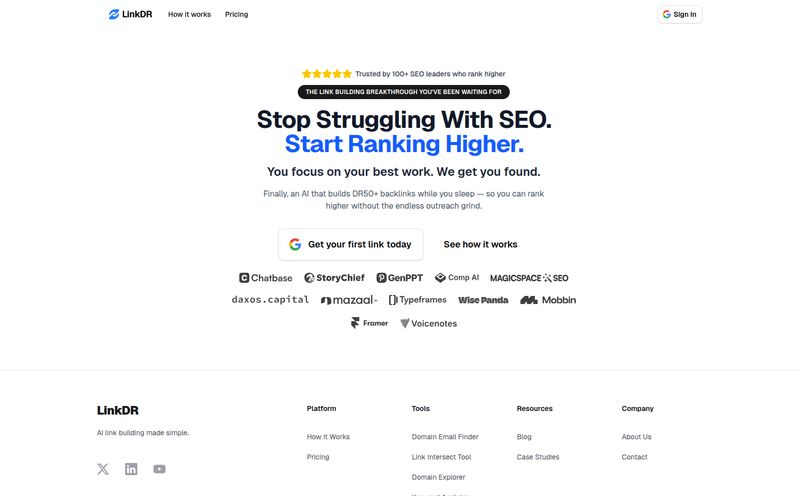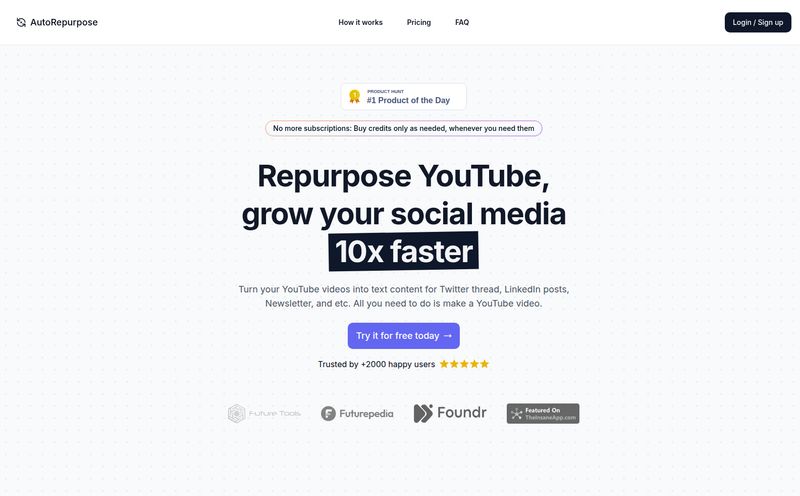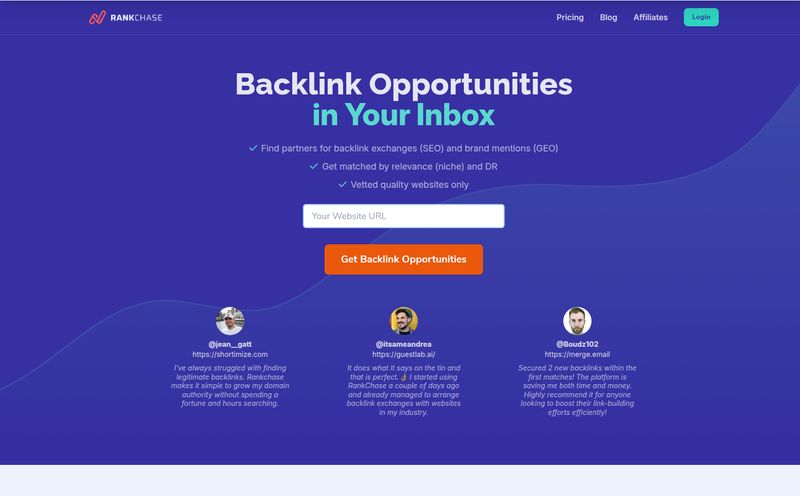As someone who's been wrestling with the content beast for years, my ears always perk up when I hear about a new tool that promises to make life easier. We're all on the same hamster wheel, right? Create, post, analyze, repeat. The pressure to constantly churn out fresh, engaging content for TikTok, Instagram Reels, YouTube Shorts… it’s a lot. So when a tool like ClipBoost pops up on my radar, claiming to breathe new life into old viral hits, you bet I'm going to take a look.
The whole premise is seductive. You have a video that absolutely crushed it six months ago. Why let it just sit in your content graveyard gathering digital dust? The idea of giving it a quick digital facelift and re-releasing it to a new audience is, frankly, a massive time and money saver. It's the ultimate work-smarter-not-harder strategy for creators. But does it actually work?
What's the Big Idea Behind ClipBoost Anyway?
At its core, ClipBoost claims to be an AI-powered tool designed to solve a very specific problem for content creators. You can't just re-upload an old video and expect the same results. Social media platforms are smart. Their algorithms can recognize a duplicate file, often by its hidden data, and they'll typically suppress its reach. It's their way of keeping the feed fresh. Your re-upload dies a quiet death, and you're left wondering what went wrong.
ClipBoost says it can fix this. It’s designed to take your old video file and scrub it clean. Think of it like a digital car wash for your content. It strips away all the old, identifying information that algorithms might flag, essentially making the video look brand new. A fresh file, a clean slate, and a second shot at virality. That’s the dream they're selling.
Breaking Down the Tech: How Does it Claim to Work?
This isn't just about changing the filename from `viral_video_1.mp4` to `viral_video_final_final.mp4` (we’ve all been there). The process is a bit more technical, and ClipBoost's features hit on the key areas that matter.
Metadata: The Content's Digital Fingerprint
Every digital file, including your videos, has a trail of data attached to it called metadata. This can include the creation date, the camera used, editing software info, and even a unique file identifier called an MD5 hash. This hash is like a unique fingerprint. If you re-upload the file, the platform's algorithm can see the MD5 hash is identical to a previous upload and might think, “Nope, seen this before. Next!” ClipBoost’s main job is to perform a full metadata cleaning and even change that MD5 hash, tricking the platform into treating it as a completely new submission.
Staying on the Right Side of Copyright
The tool also emphasizes copyright safety. Now, this doesn't mean it can magically make it okay to steal someone else's content. Let's be clear on that. It's about ensuring that when you re-upload your own content, there aren't any weird data remnants that could trigger an automated copyright flag by mistake. By cleaning the file and even altering things like the video color space, it reduces the risk of your own work being flagged against itself—a frustratingly common problem on some platforms.
The All-Important Question of Price
Of course, none of this matters if it costs a fortune. I found two main pricing tiers for ClipBoost, which seemed pretty reasonable for the target audience.
- Kickstarter Plan: This one was listed at $19 per month. It gave you 150 “cleanings” and included all the core features: Metadata Removal, ICC Profile Change, MD5 Hash Change, and Video Color Space Change. I'd say this is perfect for a solo creator or a small business owner just getting their feet wet with content repurposing.
- Pro Plan: For the more serious players, the Pro plan came in at $49 per month. This doubled the cleanings to 300 and added priority support to the mix. Probably aimed at agencies or creators who are managing multiple accounts and pumping out a high volume of content.
The pricing feels fair, especially if you consider the potential ROI from even one video going viral again. The cost of one plan is less than what you might spend on a single, mediocre boosted post.

Visit ClipBoost
A Surprising Twist in the Story
So, armed with all this info, I was genuinely intrigued. The concept is sound, the pricing is accessible... I was ready to give it a spin. I navigated over to their website, clipboost.io, to sign up and... I hit a wall. A very specific, very telling wall. The domain has expired.
Yep, you read that right. As of this writing, the website is down, displaying a notice from the registration provider. This is... awkward. It's the digital equivalent of showing up to a store for their grand opening only to find the doors boarded up. What does this mean? Has the company folded? Is it a temporary oversight where someone forgot to renew the domain? It's impossible to know for sure without inside information, but it certainly puts a damper on a glowing review. It's a stark reminder of the volatility of the SaaS world. One day you're the hot new thing, the next, your digital real estate is for sale.
Is the Content Repurposing Strategy Still Golden?
Even with ClipBoost potentially out of the picture, let's not throw the baby out with the bathwater. The strategy behind the tool is as valid as ever. Repurposing your greatest hits is one of the smartest things you can do to manage your content workload and improve your social media marketing efficiency. The core principles of cleaning metadata and making a file unique to bypass algorithmic suppression are solid SEO and social media tactics.
The effectiveness, however, always comes back to one thing: the quality of the original content. A tool like ClipBoost can give a great video a second chance, but it can't turn a boring video into a viral sensation. Garbage in, garbage out, as they say. If the hook wasn't strong the first time, or the message didn't resonate, a clean MD5 hash isn't going to fix that. But for your proven winners? It's like finding a winning lottery ticket in an old jacket pocket.
Frequently Asked Questions About Video Repurposing
Since ClipBoost itself seems to be in limbo, let's talk about the strategy more broadly. I get these questions a lot.
What exactly is video metadata anyway?
Think of it as the hidden ID card for your video file. It contains technical details like creation date, software used, framerate, and unique identifiers. Social platforms can read this data to understand the file's history.
Can't I just change the filename to trick the algorithm?
I wish! That used to work in the very early days of the internet, but algorithms are far more sophisticated now. They look at deeper data points like the MD5 hash, not just the name you give the file. Changing the name does almost nothing.
Is cleaning metadata a “black hat” tactic?
This is a great question. I'd argue no, as long as you're repurposing your own original content. You're not trying to spam the platform or deceive users with stolen videos. You're simply formatting your own work to give it the best possible chance of being seen by a new audience on that same platform. It's technical optimization, not deception.
What happens if I re-upload content without cleaning it?
Most of the time, not much. And that’s the problem. The platform will likely recognize it as a duplicate and severely limit its reach. It won't get shown on the 'For You Page' or in many feeds. It just... exists.
Are there alternatives to a tool like ClipBoost?
Yes, though they can be more technical. There are some desktop applications and command-line tools (like ExifTool) that can strip metadata, but they come with a steep learning curve. The appeal of a service like ClipBoost was its simplicity—upload, clean, download. For those less technically inclined, a simple workaround is to make a small edit to the video (trim a second off the end, add a new text overlay) and re-export it. This usually forces the editing software to generate a new file with fresh metadata.
Will this work for any social media platform?
The principle applies to most modern platforms that rely on algorithms for content discovery, including TikTok, Instagram (Reels), and YouTube (Shorts). They all have an incentive to prioritize what they perceive as new, fresh content.
So What's the Final Verdict?
ClipBoost, the tool, is currently a ghost. A fascinating idea with a great value proposition that, for whatever reason, has vanished from the internet. I'm genuinely a bit bummed, as it would have been a handy little tool in the arsenal.
But ClipBoost, the idea, is alive and well. The strategy of cleaning and repurposing your best-performing content is not only smart, it's essential for anyone feeling the burn of the content treadmill. Whether you do it by making minor edits and re-exporting or by using more technical tools, don't let your old bangers fade away. Give them a new coat of paint and send them back out into the world. You might be surprised at the results.
References and Sources
- ClipBoost Official Website (Archived/Expired): http://clipboost.io
- More on Metadata from the Adobe Blog: What is metadata, and why is it important?



